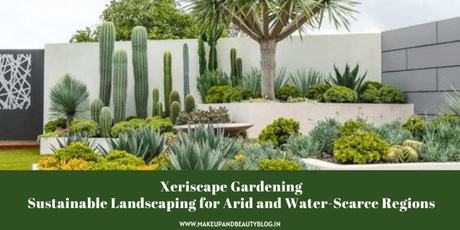
Xeriscape gardening is a sustainable landscaping practice that is becoming increasingly popular in arid and water-scarce regions around the world. The term "xeriscape" comes from the Greek word "xeros," which means dry, and "landscape," referring to the practice of creating gardens and landscapes that use little or no water.
Xeriscape gardening is based on the principles of water conservation, plant selection, soil improvement, and efficient irrigation. The goal is to create a beautiful and functional landscape that uses less water, reduces maintenance, and supports local ecosystems.
This article will explore the key principles and benefits of xeriscape gardening, as well as provide some practical tips for creating your own xeriscape garden.
Principles of Xeriscape Gardening
Xeriscape gardening is based on seven key principles that can be adapted to suit a variety of landscapes and climates. These principles are:
Planning and design: Before starting your xeriscape garden, it is important to assess the site and plan the layout and design. Factors to consider include soil type, sun exposure, wind patterns, and existing vegetation. A well-planned design can help to maximize water efficiency, minimize maintenance, and create a visually appealing landscape.
Soil improvement: Soil is the foundation of any garden, and xeriscape gardening focuses on improving soil health and fertility. Adding organic matter such as compost or mulch can help to improve soil structure, increase water retention, and support beneficial microorganisms.
Water conservation: Xeriscape gardening aims to reduce water use and waste by using efficient irrigation systems, capturing rainwater, and planting drought-tolerant plants. Water-saving techniques such as mulching and using permeable paving can also help to reduce water runoff and erosion.
Plant selection: Choosing the right plants for your xeriscape garden is crucial for success. Drought-tolerant plants that are adapted to local climate and soil conditions can thrive with minimal water and maintenance. Native plants are often a good choice, as they are well-suited to local conditions and support local ecosystems.
Efficient irrigation: Xeriscape gardening emphasizes the use of efficient irrigation systems that deliver water directly to the roots of plants, minimizing evaporation and runoff. Drip irrigation, soaker hoses, and other low-flow systems are often used to deliver water where it is needed most.
Mulching: Mulching is an important technique in xeriscape gardening, as it helps to retain moisture in the soil, suppress weeds, and regulate soil temperature. Organic mulches such as shredded leaves or bark are ideal, as they decompose over time and add nutrients to the soil.
Maintenance: Xeriscape gardening requires less maintenance than traditional gardens, but regular care is still necessary to keep plants healthy and attractive. Pruning, weeding, and fertilizing may be required, depending on the type of plants and soil conditions.
Benefits of Xeriscape Gardening
Xeriscape gardening offers numerous benefits for both homeowners and the environment. Some of the key benefits include:
Water conservation: Xeriscape gardening can reduce water use by up to 60%, compared to traditional landscaping. This not only helps to conserve water resources, but can also save homeowners money on their water bills.
Reduced maintenance: Xeriscape gardens require less maintenance than traditional gardens, as they are designed to be self-sustaining and require minimal watering and pruning.
Increased biodiversity: Planting native plants in xeriscape gardens can help to support local ecosystems and attract a variety of wildlife, including birds, butterflies, and bees.
Improved soil health: Xeriscape gardening emphasizes soil improvement.
Reduced environmental impact: Xeriscape gardening can help to reduce the environmental impact of landscaping practices by minimizing water use, fertilizer and pesticide application, and carbon emissions from lawn mowers and other equipment.
Increased property value: A well-designed xeriscape garden can add value to a property, as it creates an attractive and functional landscape that requires less maintenance and water.
Tips for Creating a Xeriscape Garden
If you are interested in creating your own xeriscape garden, here are some practical tips to get you started:
Assess your site: Before starting your xeriscape garden, assess your site to determine soil type, sun exposure, wind patterns, and existing vegetation. This information can help you to select the right plants and irrigation system for your garden.
Plan your design: A well-planned design can help to maximize water efficiency, minimize maintenance, and create an attractive landscape. Consider incorporating features such as berms, swales, and rain gardens to capture and retain water.
Choose the right plants: Choose plants that are adapted to your local climate and soil conditions, and that require minimal watering and maintenance. Native plants are often a good choice, as they are well-suited to local conditions and support local ecosystems.
Install efficient irrigation: Install an efficient irrigation system that delivers water directly to the roots of plants, minimizing evaporation and runoff. Drip irrigation, soaker hoses, and other low-flow systems are often used to deliver water where it is needed most.
Use mulch: Use organic mulch such as shredded leaves or bark to help retain moisture in the soil, suppress weeds, and regulate soil temperature.
Maintain your garden: Xeriscape gardens require less maintenance than traditional gardens, but regular care is still necessary to keep plants healthy and attractive. Pruning, weeding, and fertilizing may be required, depending on the type of plants and soil conditions.
Conclusion
Xeriscape gardening is a sustainable landscaping practice that is gaining popularity in arid and water-scarce regions around the world. By using efficient irrigation systems, selecting drought-tolerant plants, and improving soil health, xeriscape gardens can reduce water use and maintenance, support local ecosystems, and create beautiful and functional landscapes. With some careful planning and design, homeowners can create their own xeriscape gardens that are both sustainable and visually appealing.
Image source: milehighlandscape.com'This post is part of #BlogchatterA2Z challenge'. Also A part of Blogchatter's CauseAChatter
